Failover vs. Failback: Two Disaster Recovery Methods
A key distinction in the realm of disaster recovery is 关键字1the one between failover and failback. Both terms describe two sides of the same coin, complementary processes that are often brought together.
However, their effects and purposes couldn't be more different. Both play critical roles in ensuring business continuity and disaster recovery, making it essential to understand what they are and how they differ.
What is Failover?
Failover is a business continuity operation that ensures continued access to a system by fully transitioning to another instance of that system. This secondary system is designed to be resilient, ideally unaffected by the event that compromised the primary system.

Put simply, failover occurs when connectivity is switched from one system instance to another. This can happen in various ways, including:
Editor's Note:
This guest blog post was written by the staff at Pure Storage, an US-based publicly traded tech company dedicated to enterprise all-flash data storage solutions. Pure Storage keeps a very active blog, this is one of their "Purely Educational" posts that we are reprinting here with their permission.
- Switching from a primary system to a standby system
- Transitioning to a hot or cold spare
- Activating a backup system during a failure or for testing purposes
- Switching either manually or automatically
The critical point about failover is that it involves a complete migration of logical or physical access from the primary system, server, or hosting location to a secondary one.
While other processes, such as load balancing, may distribute partial connectivity between system instances or components, they do not qualify as failover because they do not represent a full cutover.
What is Failback?
Failback is the quintessential disaster recovery operation. It involves a full migration back to the production status quo – a recovery if you will – at the validated conclusion of a disaster.

Failback occurs when a system reverts back to the primary environment after the root cause of a disruption has been addressed. In practice, this looks like a failover, but in reverse. Once the primary system is restored, access is pointed to that system, and the standby is deactivated.
This reversion is a critical distinction. Some organizations may have complete standby systems for critical applications, which permit full operations on the standby system. In that case, the standby can rightfully be considered the primary and the repaired former primary the new standby.
The Role of Failover and Failback in Disaster Recovery
Failover is critical in a business continuity event because it keeps operations running. By having a system to which your business can transition when a primary system is unavailable, you're able to continue doing business. People can work, revenue streams are preserved, and customers can be served.
Without failover, these functions could grind to a halt, leading to significant disruption. Many organizations depend on technology for critical processes, and when those processes are unavailable, analog alternatives may be insufficient or entirely obsolete. Failover ensures that even in a disaster, the business keeps moving.

Failback comes into play once the need for failover ends. As the disaster is resolved, failback allows the organization to return to normal operations. Typically, failback is necessary when the standby system cannot sustain operations as effectively as the primary system. For instance, a standby system may not be a full replica of the primary system and might be designed only for temporary use during an emergency.
For mission-critical systems, some organizations may build a standby system that is a full replica of the primary. While costly, this approach mitigates the risks of diminished functionality during disasters.
The Benefits of Leveraging Both Failover and Failback
In an ideal world, every business would maintain two fully operational environments: a primary environment and an identical standby environment. This setup would allow for seamless transitions during disasters, ensuring that business operations are completely unaffected.
However, that model can effectively double an IT budget: two sets of endpoints, two sets of servers, two sets of cloud environments, two sets of data, staff to support that both in IT and business operations, etc. It's costly and inefficient for any company, to the point where no company truly maintains that support model.

Instead, most organizations opt for a failover and failback model because it balances cost and efficiency. With this approach, the standby environment is designed to sustain critical operations during a disaster, even if it's not as robust as the primary system. This makes it more economical, less work is duplicated, and the risk of data loss or impact is lower.
It's crucial to maintain a well-designed secondary environment. Cutting costs too deeply on a standby system can result in inefficiencies or financial losses if critical operations are disrupted. Striking the right balance between cost and functionality is key.
If uninterrupted business operations are essential, then a strategic failover and failback plan is not optional – it's a necessity.
- ·营销策划集合[10篇]
- ·郑钦文仰望!世界第一2
- ·在Win7下怎么设置才能提高多核CPU的速度
- ·从礼花到港珠澳大桥!一枚奖牌把粤港澳的浪漫全装进去了
- ·โฆษก ทบ.แจงกรณีทหารกัมพูชาหันปืนใหญ่เข้ามาฝั่งไทย ชี้ได้ปรับกำลังให้เหมาะสมกับสถานการณ์
- ·忙忙碌碌只为碎银几两的说说 为了挣几两碎银感悟说说
- ·青马课堂:安全骑马指南(下)
- ·世联最新排位:中国女排下跌第4,日本升第1
- ·封神幻想世界法宝合成方法 封神幻想世界法宝怎么合成
- ·暖冬守护 保供同行
- ·大热天干活怎么发朋友圈 顶着大太阳在干活的说说
- ·女排轮换打乱原因找到 龚翔宇发声 王媛媛祝福
- ·八部门:探索建立长江经济带重点行业企业和个人碳账户
- ·尘埃落定!中国女排新版七仙女揭晓
- ·全国重点城市次日达!从化荔枝“解锁”极速直达模式
- ·中国女排18人大名单出炉!李盈莹因伤缺阵
- ·如鸢金卡养卡推荐一览 如鸢金卡养哪个
- ·权志龙否认与李珠妍恋爱 两人之前曾被D社拍到
- ·aespa将于6月27日回归 发行单曲新专《Dirty Work》
- ·尘埃落定!中国女排新版七仙女揭晓
- ·社区“新宠”——智能垃圾分类桶
- ·韩剧《学习小组》将拍摄第二季 黄旼炫主演
- ·光宝前进SNEC PV+上海国际太阳能光伏与智慧能源大会 聚焦光耦合新能源应用 全面引领系统安全与效率升级新趋势
- ·园区搭台打通校企合作“最后一公里” 毕业生就业、企业发展双向奔赴
- ·黑色信标猴子打字机活动玩法说明
- ·Call of Duty: Warzone Season 04 Vondel Tactical Preview — SpecGru Recon Operation Declassified

